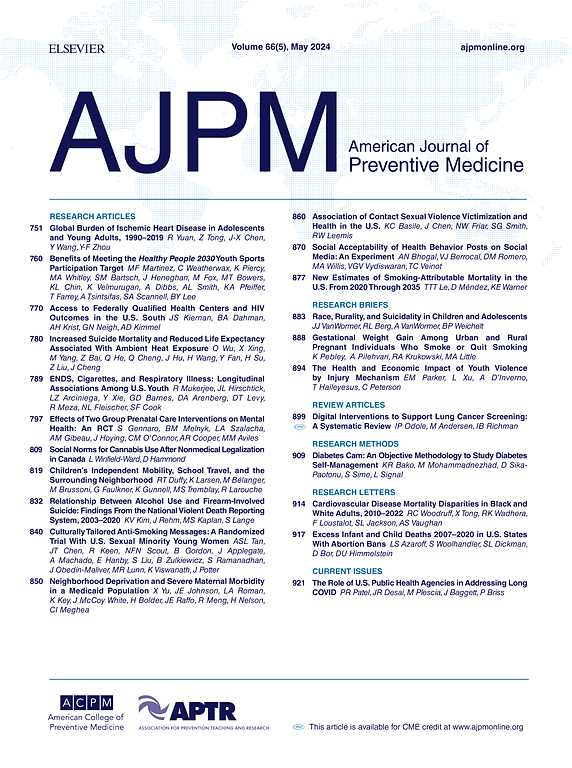有肩撞击综合征病史的美国陆军士兵肩袖撕裂风险增加
IF 4.5
2区 医学
Q1 MEDICINE, GENERAL & INTERNAL
引用次数: 0
摘要
简介:由于职业需求、健康标准和体力活动,军人和高体力活动平民的可比群体可能会经历肩部负荷增加。这些增加的上肢需求可能增加发生肩撞击综合征的风险。假设肩撞击会增加肩袖撕裂的风险,这是一种影响长期表现的损伤。方法:这是一项嵌套、匹配的病例对照研究,使用2016-2021年美国陆军现役士兵的数据(N = 869,651)。根据年龄、性别、进入研究的日历日期和服役时间,将发生肩袖撕裂的病例与4名没有肩袖撕裂的对照组相匹配。泊松回归用于确定发病率,Cox模型用于估计风险比。结果:肩关节撞击和肩袖撕裂的发生率分别为每1000人年2.24 (CI: 2.10-2.39)和0.94 (CI: 0.86-1.03)。有撞击史的士兵发生撕裂的危险率比没有撞击史的士兵高(HR: 2.46, CI: 2.28-2.66)。结论:肩撞击综合征与肩袖撕裂的风险增加有关。在各个年龄组中,肩袖撕裂的损伤风险窗口期为2 - 4年,而对于那些先前有肩撞击的人来说,损伤风险窗口期不到1 - 2年。本文章由计算机程序翻译,如有差异,请以英文原文为准。
Increased Risk of Rotator Cuff Tear in U.S. Army Soldiers With a History of Prior Shoulder Impingement Syndrome
Introduction
Military populations and comparable groups of highly physically active civilians may experience increased shoulder loading due to occupational demands, fitness standards, and physical activity. These heightened upper extremity demands may increase the risk of developing shoulder impingement syndrome. Shoulder impingement is hypothesized to increase the risk of rotator cuff tears, an injury with long-term performance implications.
Methods
This is a nested, matched, case-control study using data from active-duty U.S. Army Soldiers from 2016 to 2021 (N=869,651). Incident rotator cuff cases were matched to 4 controls without a prior rotator cuff tear by age, sex at accession (male or female), calendar date of entry into the study, and service time. Poisson regression was used to determine incidence rates, and Cox models were used to estimate hazard ratios. This study was approved by the IRB of the U.S. Army Medical Research and Development Command.
Results
The incidence of shoulder impingements and rotator cuff tears was 2.24 (95% CI=2.10, 2.39) and 0.94 (95% CI=0.86, 1.03) per 1,000 person-years, respectively. Soldiers with a history of impingements had a higher hazard rate for developing a tear (hazard ratio=2.46, 95% CI=2.28, 2.66) than soldiers with no history of impingement.
Conclusions
Shoulder impingement syndrome is associated with an increased risk for rotator cuff tears. Across age groups, the injury risk window for a rotator cuff tear was 2–4 years and less than 1–2 years for those with a prior shoulder impingement.
求助全文
通过发布文献求助,成功后即可免费获取论文全文。
去求助
来源期刊

American Journal of Preventive Medicine
医学-公共卫生、环境卫生与职业卫生
CiteScore
8.60
自引率
1.80%
发文量
395
审稿时长
32 days
期刊介绍:
The American Journal of Preventive Medicine is the official journal of the American College of Preventive Medicine and the Association for Prevention Teaching and Research. It publishes articles in the areas of prevention research, teaching, practice and policy. Original research is published on interventions aimed at the prevention of chronic and acute disease and the promotion of individual and community health.
Of particular emphasis are papers that address the primary and secondary prevention of important clinical, behavioral and public health issues such as injury and violence, infectious disease, women''s health, smoking, sedentary behaviors and physical activity, nutrition, diabetes, obesity, and substance use disorders. Papers also address educational initiatives aimed at improving the ability of health professionals to provide effective clinical prevention and public health services. Papers on health services research pertinent to prevention and public health are also published. The journal also publishes official policy statements from the two co-sponsoring organizations, review articles, media reviews, and editorials. Finally, the journal periodically publishes supplements and special theme issues devoted to areas of current interest to the prevention community.
 求助内容:
求助内容: 应助结果提醒方式:
应助结果提醒方式:


